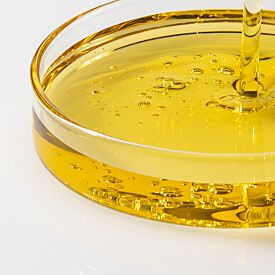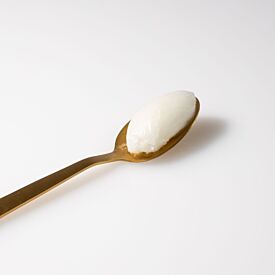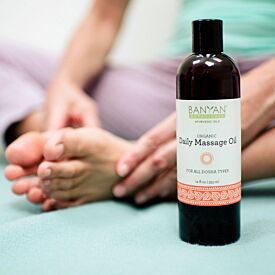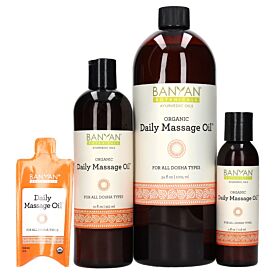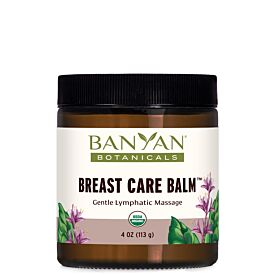Why You Should Be Massaging Your Breasts on the Reg
Getting to the Heart of the Matter
Over the last ten years of practice as a massage therapist, I can honestly say I’ve touched a lot of bodies. Feet and hands, arms and legs, not to mention all those “knots” in the upper thoracic muscle. Touch is said to be a significant tool in supporting our health when dealing with psychosomatic (mind/body) conditions. It allows for a rush of oxytocin and serotonin to flood the body with those feel-good hormones! Massage provides both a socially supportive experience and palliative care (pain relieving) for those enduring breast cancer treatments; it may lessen the anxiety that could possibly prevail in the mind.1
Breast cancer is one of the most common types of cancer affecting women today, and we must look at care as a multi-dimensional approach. Whether you are currently or have in the past experienced breast cancer or any emotional challenges in life, massage can be a beautiful addition to your self-care practices. While the following bodywork suggestions are not meant to be an alternative to one’s primary health care, they may be a supportive post-treatment protocol to help you through the psychosomatic repercussions of any experience affecting the heart and chest regions. Please speak with your physician before partaking in massage, especially if you are currently in chemotherapy or radiation treatment. A brief intake and review of medical history is also necessary if one chooses to include herbal oils in their massage.
We will be talking about two types of bodywork techniques—both can be self-applied. The first term is hrid basti. Basti refers to a dough dam made from black gram or chickpea flour which is placed on the surface of the skin. Most bodyworkers trained in panchakarma techniques will know how to perform this during your massage session. After the dough dam is placed onto the skin, warm oil such as Daily Massage Oil or plain Sesame Oil is poured into the space. This is a great time for you to practice affirmations or your favorite mantra, like Om Mani Padme Hum. The Sanskrit word for the fourth chakra is anahata, meaning “unstruck.” I find this word unstruck to be sort of odd honestly, considering many experiences in life can “strike a chord” on our heart strings. The heart chakra and the granthis (knots) formed here stem from the bondage of our actions. All thoughts, images, and experiences of life affect this energetic center. Visualizations can be used as you receive this treatment, such as imagining the color green, which is related to the heart chakra, emanating from the heart. Using a simple bija mantra, Yam (which also relates to the heart chakra), or wearing jade or rose quartz as a pendant so that it rests in the heart space region, can enhance the energetic work on this area of the body.
While hrid basti is traditionally performed on the back of the body, lying face down may not be a comfortable option for everyone. This technique can be performed on the anterior (front) chest to accommodate a more comfortable position for you. This type of placement also allows the therapist to address the chest and breast without massaging the breast tissue. In the United States, there are laws in certain states that restrict direct, hands-on work to the breast tissue. Check with your therapist about their training and experience. Don’t be afraid to ask! We love to talk about our education.
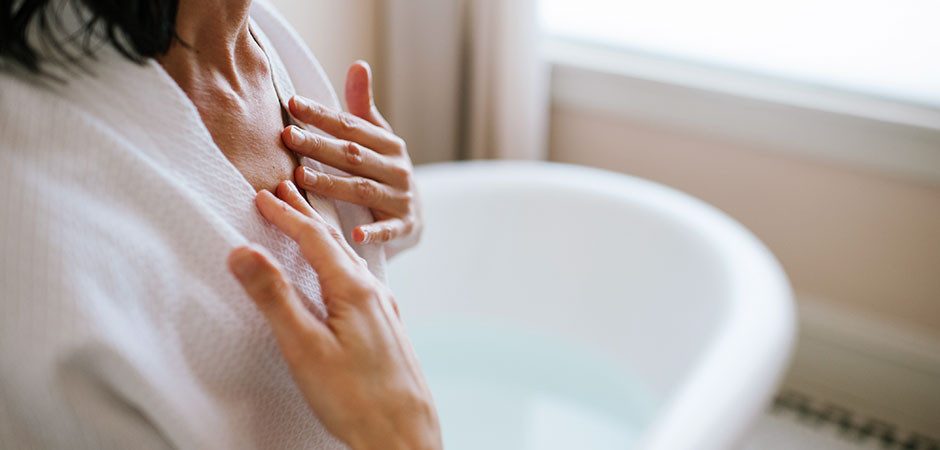
We Are Our Best Caretakers
Ladies, let’s face it. Learning how to be our own caretakers takes an honest approach and continuous attention. Take a moment to pause where you are right now. Place your hands onto your heart space. Breathe. Notice. Feel the weight of your palms resting upon your chest. Attune your hands to your heart space at least once a day. Notice the texture of your skin. From there we can build into our daily practice of breast massage.
Daily self-massage trains our hands and fingers to notice any changes in our tissue. It is best to choose natural and organic oil such as organic Sesame or Coconut, or even Banyan’s own formula, Breast Care Balm. The special ingredient, palmarosa (Cymbopogon martinii), often finds a place in our skin care products. It regulates skin moisture and oil production and is therefore useful for both dry and oily skin conditions. Vata and pitta vikriti comes to my mind.
A Deeper Look Inside
The glandular tissues that compose the breasts are sensitive to estrogen, progesterone, and prolactin levels during menses and pregnancy. The breasts are a supportive lymph system structure with mammillary glands, but more important are the axilla watersheds. Watersheds are regions with large numbers of lymph nodes. Anytime we speak of lymph, we must consider rasa dhatu. Lymph nodes are traversed by both the superficial lymphatic vessels (those that drain the skin and follow venous return) and the deep vessels (those that receive the drainage of the internal organs). Once you have chosen your preferred oil or balm, sit down, get comfy, and let’s begin!
Attune your hands once again to your heart space. Rest your palms above your breasts. Place your peace fingers (index and middle) just below your sternal notch. Begin now moving both full palms in a crescent shape stroke down the sternum, sweeping partially under the breast and then back up. After a couple repeated crescent sweeps, move both palms with fingers pointed up towards your clavicles, moving outward from the chest. A general rule of massage technique is to work proximal to distal (from center out towards limbs) and then back to proximal.
It is important to note the anterior group of lymph nodes lies deep to the pectoral major muscle and inferior (lower) along the pec minor muscle. This area is commonly tender for most individuals so work one side at a time, gliding gently and slowly, moving strokes towards the armpit. As your fingers sink into the lateral region under the arm, give a moment to hold with a full palm compression. Slide up and over the shoulder and continue up towards the ear, then back down the anterior neck. Have fun with it and notice how relaxed and breathable your heart center feels when done. Smile. YOU ARE BEAUTIFUL.
Last Note for Breast Care
-
Keep in mind during breast feeding, both compression and gentle breast massage can help keep a baby actively sucking during breastfeeding, and continue to provide comfort to the breast tissue.
-
Take care of your girls! Give them a break once in a while from restrictive supportive devices (underwire bras) and go for the softer supports like camisole or sports bras.
May each of you be healthy. May each of you be happy. May each of you be well. Om Shanti, Shanti, Shanti.



